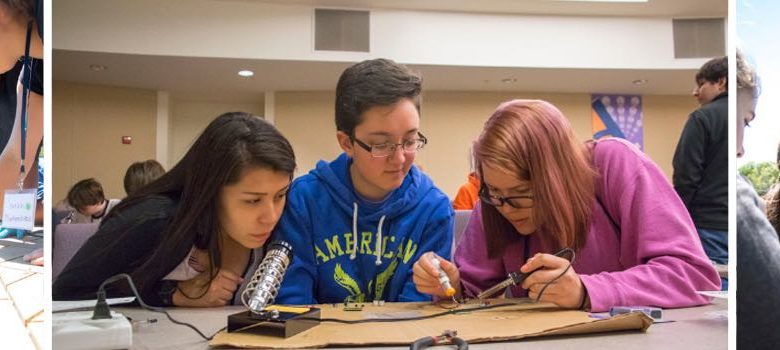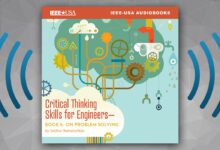
“Awesome” has been called the word most Americans use to describe almost everything these days. More traditionally, it’s also a term for defining something that’s outstanding or extraordinary.
Either way, “awesome” is an apt description for the STEM literacy program that is part of a unique, hands-on collaboration between the University of Maine (UMaine) and Bangor High School. The partnership is the work of IEEE Senior Member Mohamad Musavi, associate dean of UMaine’s College of Engineering and Cary James, the head of Bangor High’s science, technology and engineering department. Last year, IEEE-USA honored the two men with its prestigious 2014 IEEE-USA K-12 STEM Literacy Educator-Engineer Partnership Award for creating SMART-the acronym for Stormwater Management Research Team.
The program they designed, and now co-direct, provides hands-on opportunities for girls and underrepresented minority groups from throughout the state to apprentice with UMaine faculty members-and also take a demanding sequence of STEM courses. Funded by a National Science Foundation EPSCoR Award (IIA-1348266), SMART enables high school students to make a difference in their community’s environmental issues, by becoming involved as year-long, paid interns in water quality monitoring and management.
“It’s vital that we increase the pipeline of educated people, especially after the economic meltdown of a few years ago,” says Musavi. “I met Cary James while my daughter was attending Bangor High School, and during our parent-teacher interactions, it became clear that he was the person to champion such a program among the students.”
Musavi and James selected stormwater runoff for study because managing it effectively is a widespread environmental concern. In addition, the SMART solution-focused program model is relevant and appealing to communities.
At the first SMART Institute in June 2014 at UMaine, 55 students attended from four high schools and tribal communities from across the state. Eleven teachers also attended because, as Musavi explains it, “This new way of teaching also requires training the teachers how to do it.”
For three days, the students and their teachers met with university faculty, engineering students, and city and state water planners to learn about the issues-as well as the engineering-of storm water. Using the latest sensor technology for data collection and computer modeling of data analysis, they taught the students how to use water-quality wireless sensor network units; collect real-time data with probes and sampling; manage and use the data through lab analysis and the techniques; and investigate solutions to stormwater problems.
Back in their communities, during the 2014-15 school year, students continued to test water near their homes, and to work with staff at local water districts to research solutions. The interns earned $600 while participating in the program, which included the three-day summer SMART Institute, and two hours each week during the school year for stormwater-related activities.
In June 2015, the second SMART Institute at UMaine drew 78 students and 13 teachers from 12 high schools and tribal communities throughout the state. Now an annual event, the next SMART Institute will be 26-29 June 2016.
Lacking the financial resources to professionally market the SMART program, Musavi and James have instead been presenting it to audiences at educator conferences throughout the United States. “The reception at meetings like Science Counts and the American Society for Engineering Education has been beyond what we imagined,” says James. “The response has been gratifying, and we have tremendous interest from high schools and universities in New York, Texas, Idaho and Missouri-to name just a few.”
Preliminary evaluation data show that experiences like those that SMART provides are effective in promoting interest in STEM education and careers. Students currently in the program reported that it has made them “somewhat” or “to a great extent” more likely to apply to a STEM program in college. The components that most appeal to them include participating in real-world, community-based research opportunities (83.1%); using these experiences to research real issues facing their community (93.7%); and helping to solve these problems (95.3%).
SMART has also demonstrated that it promotes interest in STEM education and careers, specifically among females and minorities. The majority of current program participants are girls (56.9%); and nearly a third (30.8%) are from ethnic minority groups-one in six is Native American (16.9%).
Designed to be replicated in high schools throughout the United States, James says that after a university and a high school have agreed to partner, the key to a successful program is to pick an environmental topic that can be highly interactive for students, engages them with their communities, and encourages innovative solutions. “Stormwater runoff is a pervasive problem throughout the United States, but other schools might find energy-or food-related issues-of greater interest in their particular geographic areas,” he observes. “What matters most is an issue that will involve students, enabling them to learn engineering skills, while helping to prepare them for college and a career.”
According to Musavi, IEEE members can be vital links in encouraging STEM education for girls and underrepresented minorities. “Members who are on university faculties can duplicate in their communities what we have accomplished in Maine. But IEEE members who want to encourage STEM literacy among girls and underrepresented minorities can also get involved by approaching high schools, industries, and city and state partners,” he says.
Details about the UMaine STEM literacy program and the 2016 SMART Institute are at https://umaine.edu/smart/.
Mohamad Musavi and Cary James also welcome inquiries at musavi@maine.edu and chemjames@gmail.com, respectively.
| Paige Brown’s Passion for Water Research By Helen Horwitz In some respects, Paige Brown of Bangor, Maine (pictured right), is a typical 17-year-old. She’s always loved to climb trees, is close to her younger brother, and one of her favorite adjectives is “awesome.” But except for a few more characteristics she shares with other teens, calling Brown “typical” ends there. In fact, the word “awesome” describes her very well. Despite her tender years, she is already an expert on pollution in six Bangor waterways. In 2015, her work earned her Maine’s Stockholm Junior Water Prize-a prestigious award sponsored by the Stockholm International Water Institute-and designed to encourage young people’s interest in water and environmental issues. More recently (20 January 2016), Brown was named one of the 40 finalists in the 2016 Intel Science Talent Search. Along with the other high school seniors, she will participate 10-16 March in Washington, D.C., in what is perhaps the nation’s leading pre-college science and math competition. Students will compete for more than $1 million in awards, provided by the Intel Foundation. Brown’s curiosity about science ignited during eighth grade, when she read an article about photosynthesis, the process that changes the color of leaves. “I’d always wondered about this when I climbed trees, and the article completely absorbed my interest,” she says. As a sophomore in an advanced placement chemistry class that Cary James taught at Bangor High, Brown and other students obtained and analyzed a water sample from the streams and brooks that flow though Bangor. Brown’s sample revealed a very high phosphorus level. And she admits to having a passion for research-so Brown expanded her project to include six local waterways already identified as polluted. Since she doesn’t have a driver’s license, her mother drove her to the 28 sampling locations Brown had established. In her early research, Brown used laboratory space at Bangor High School to process her samples. But during the summer of 2014, when she found it too difficult to get into the school so she could work, the committed young researcher moved her lab to her parents’ basement-where she used borrowed and donated equipment. Brown found many contamination issues. Many streams were adulterated with phosphorous-contributing to algae bloom growth, blocking sunlight, and preventing other aquatic plants from growing. These factors affect all life in the steam, including fish. Every stream she studied was contaminated with E. coli, exceeding EPA standards. These issues and more could be traced to stormwater runoff, a major problem in many communities. In June 2015, Brown attended the SMART Institute at the University of Maine, where she presented her findings in a keynote presentation to the other students, as well as teachers, university faculty, city water planners and state officials. She also traveled to Herndon, Virginia, where she competed for the national Stockholm Junior Water Prize. She didn’t win, but she made valuable connections with water researchers from other states, including Kentucky and Colorado. “Collaboration starts to happen when you bring all those water researchers together,” she notes. With high school graduation approaching, Brown wants to study chemical engineering this fall at either Yale, or Massachusetts Institute of Technology, although she has already been offered a full scholarship to Drexel University. “I want to help the world with a remediation technology that inexpensively removes phosphorous from water and protects our nation’s-and the world’s-water sheds,” she says. And as almost everyone will agree, that’s awesome! |
Helen Horwitz is an award-winning freelance writer who lives in Albuquerque, N.M. She was with IEEE from 1991 through 2011, the first nine as Staff Director, IEEE Corporate Communications.






